Economy

Manufacturing Update: Slowdown’s Indisputable
Written by Peter Wright
April 22, 2019
Most indicators of manufacturing activity are still positive, but evidence of a slowdown is indisputable.
This report summarizes 11 data streams that describe the state of U.S. manufacturing in general and the steel industry in particular. We have reported on most of these separately in our Steel Market Update publications and therefore will be brief in this summary. We don’t expect these data sources to all point in the same direction. Our intent in summarizing them in one document is to provide a consensus of the state of this critical steel-consuming sector. Based on American Iron and Steel Institute estimates of steel mill shipments by market classification, almost 50 percent of the steel consumed in the U.S. is manufacturing-oriented. This breaks down to about 27 percent in ground transportation, 9 percent in machinery and equipment, 5 percent in appliances, 4 percent in defense and 4 percent in containers.
Figure 1 summarizes the 11 individual data streams. All indicators except manufacturing capacity utilization, automobile sales and the ISM Index have positive growth on a year-over-year basis. However, growth rates of all of the indicators are slowing and the decline in manufacturing capacity utilization was the first since April 2017.
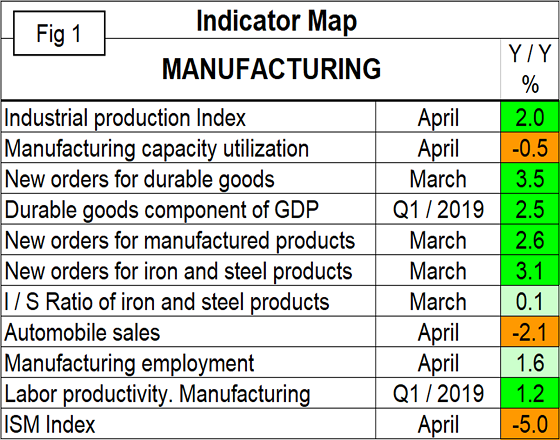
The Industrial Production Index
Figure 2 shows the three-month moving average (3MMA) of the IP index since January 2007 as the blue line and the year-over-year growth as the brown bars. March 2017 was the first month of positive growth in the 3MMA since April 2015. Growth peaked at 5.8 percent in October of last year and has contracted every month since then. Manufacturing capacity utilization improved from 74.48 percent in January 2017 to 77.01 percent in December last year and has declined every month in 2019, reaching 76.02 percent in April with a negative year-over-year growth rate of 0.5 percent on a 3MMA basis (Figure 3).
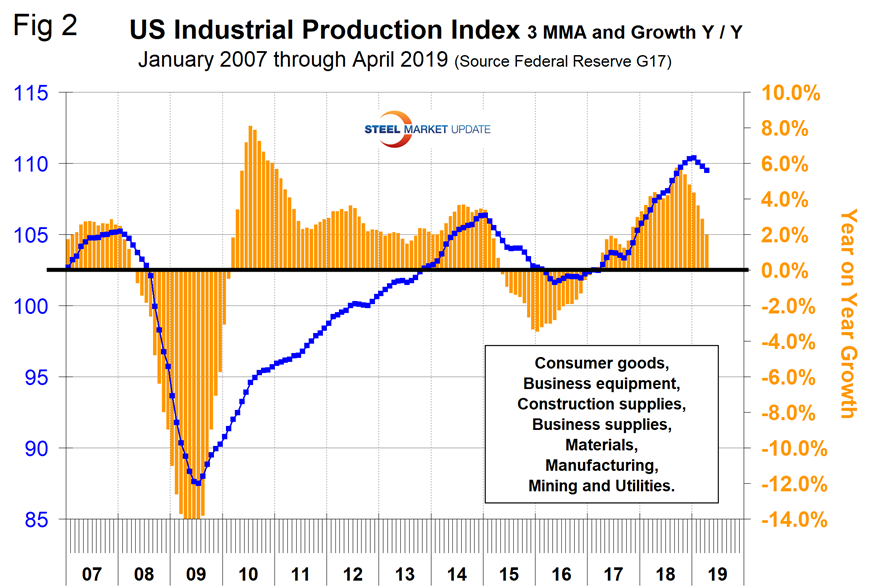
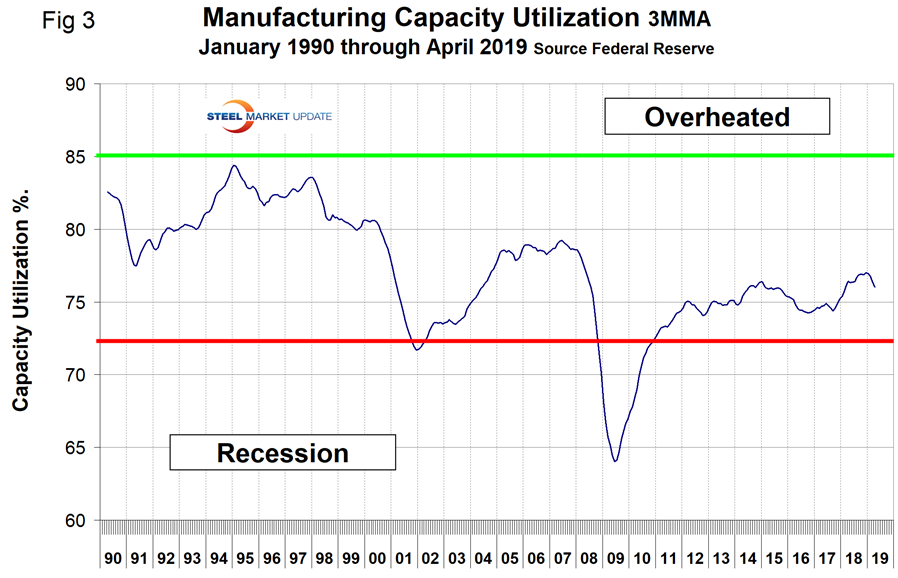
New Orders for Durable Goods (Advance Report)
The year-over-year growth rate of durable goods reached 9.7 percent in September last year and since then has declined to 3.5 percent in March. Figure 4 shows the 3MMA since January 2010. This is considered to be one of the earliest indicators of both consumer and business demand for U.S. manufactured goods.
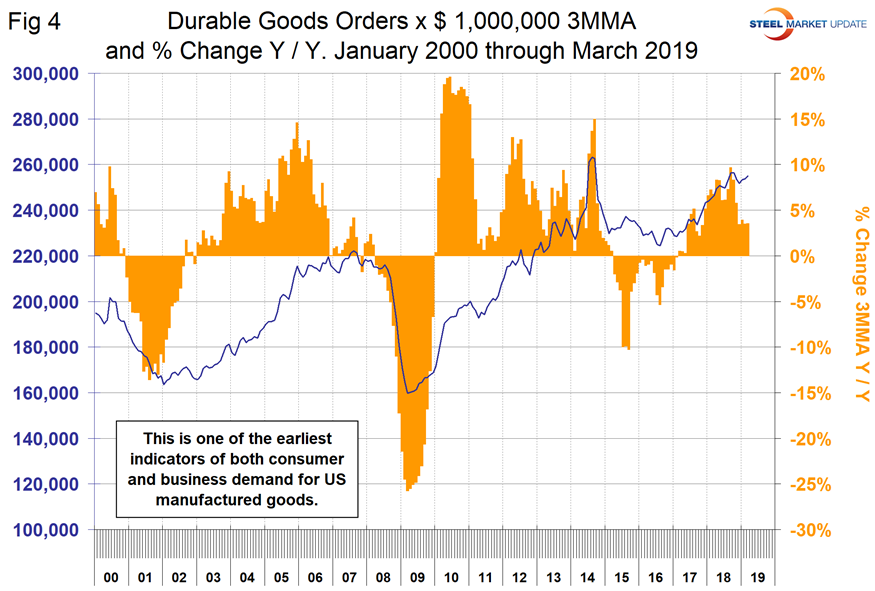
The Durable Goods Portion of GDP
The first estimate of Q1 2019 GDP growth was reported as 3.2 percent annualized, which was up from 2.2 percent in Q4 2018. A subcomponent of the quarterly data is durable goods, which is part of the personal consumption calculation. It therefore contains no military hardware or civil aircraft data. This is shown in Figure 5 and, presumably because of the exclusions just mentioned, looks nothing like the blue line in Figure 4. The durable goods portion of GDP declined from $1.692 trillion (annualized) in Q4 2018 to $1.669 trillion in Q1 2019.
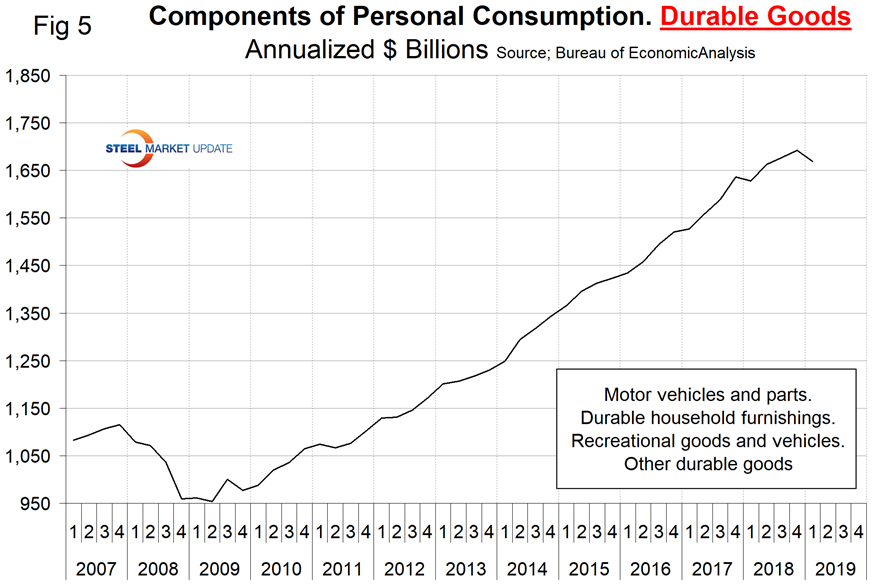
New Orders for Manufactured Products
New orders for manufactured products as reported by the Census Bureau declined every month October through March on a 3MMA basis. In March, the year-over-year growth was 2.6 percent, down from 9.0 percent in September.
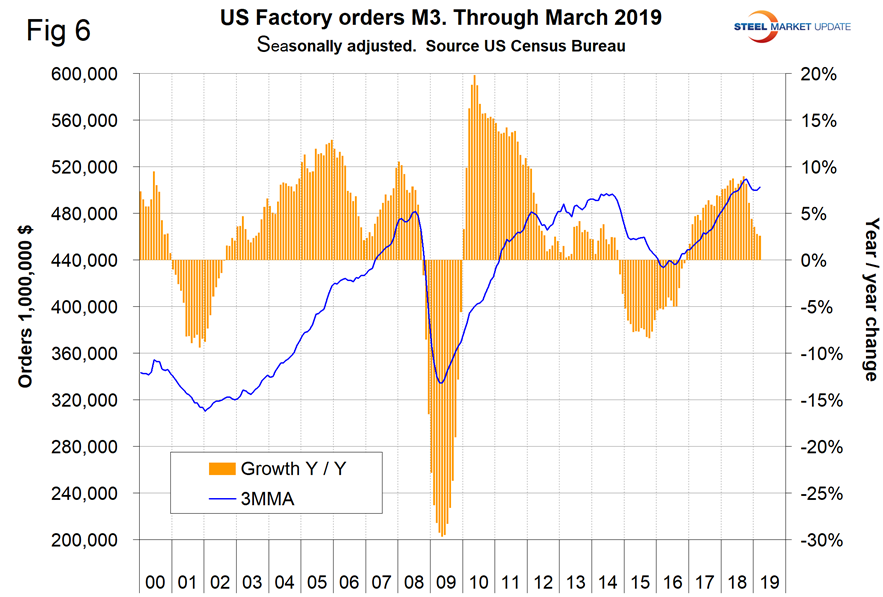
New Orders for Products Manufactured from Iron and Steel
Within the Census Bureau M3 manufacturing survey is a subsection for new orders for iron and steel products. Figure 7 shows the history since January 2000. The year-over-year growth rate has declined since September and the order volume has plateaued since July last year.
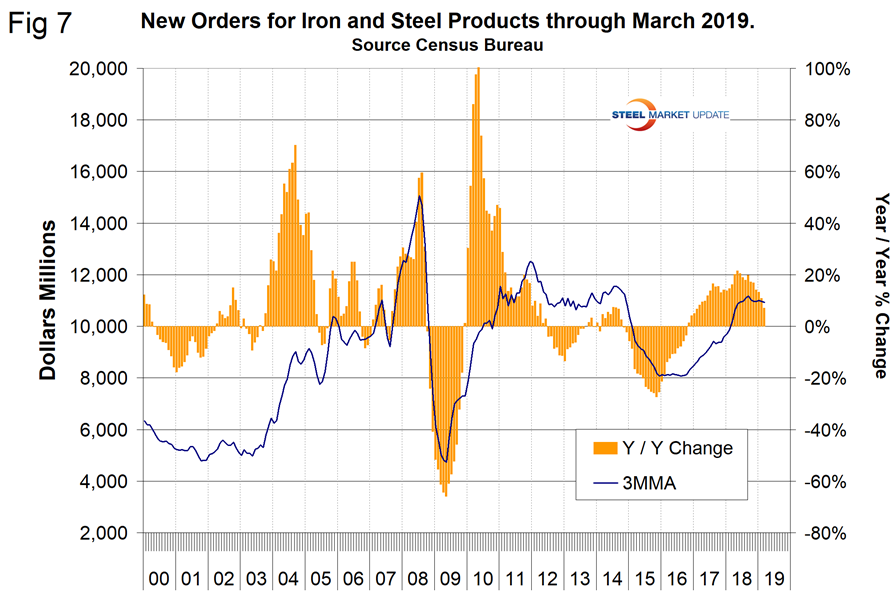
Inventories of Products Manufactured from Iron and Steel
The inventory build was at a rate of 12.2 percent year over year in December and fell to 7.3 percent in March (Figure 8). Month over month, inventories declined in both February and March. We regard this as supportive of the data showing a flattening trend for new orders.
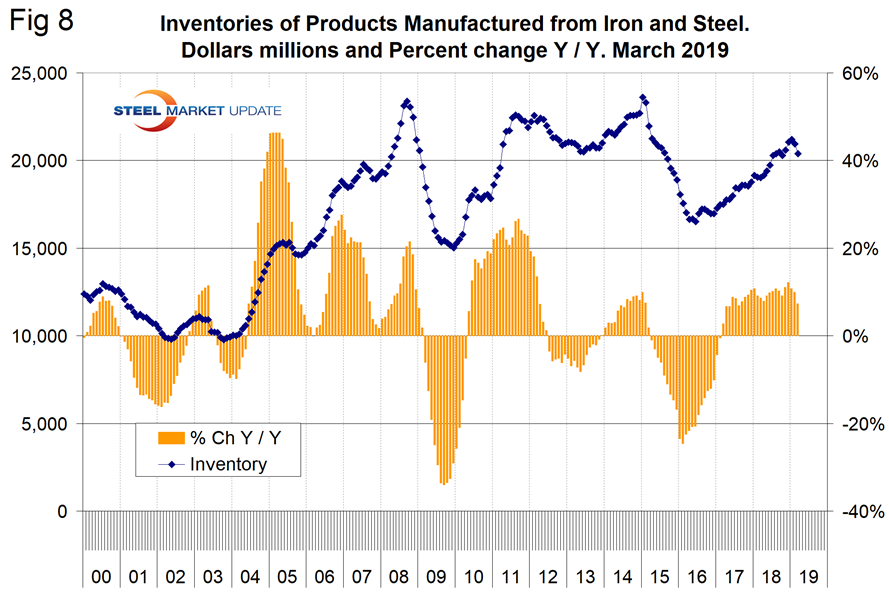
Light Vehicle Sales in the U.S
Automobile sales have trended down slightly in the last three years as measured by the cyclical peaks. Year over year on a 3MMA basis sales were down by 2.1 percent. Sales in April totaled 16.4 million units annualized and were comprised of 70.1 percent light trucks and 29.9 percent autos. The declining sale of autos in the last three years has resulted in GM announcing its intent to close several small car plants. The light truck category includes SUVs and crossovers. Overall, sales are still higher than the pre-recession level (Figure 9). Import market share in April was 23.8 percent and has been drifting up since September 2015.
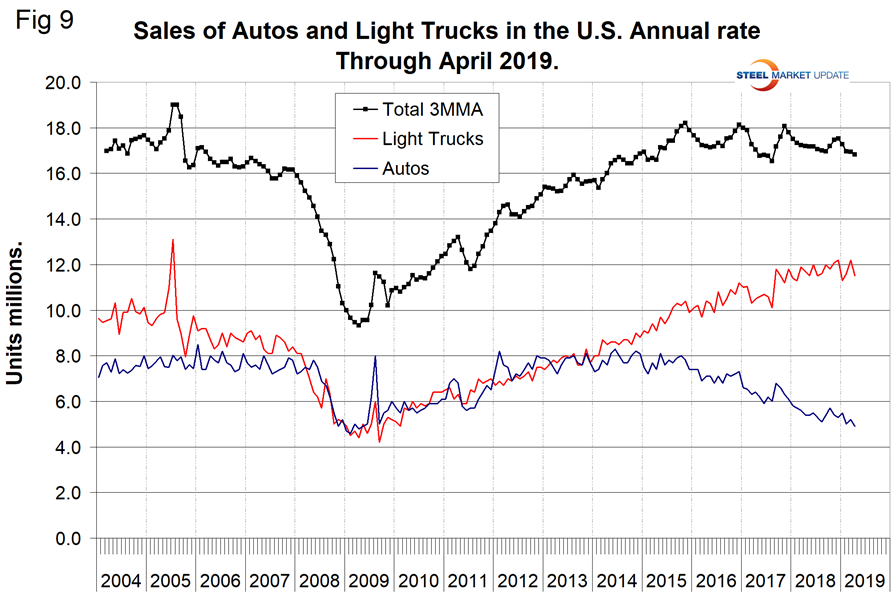
Manufacturing Employment
Manufacturing employment plummeted during the recession and gradually improved from the spring of 2010 through 2014. Growth was flat in 2015 and declined slightly in 2016 when 23,000 jobs were lost during the year as a whole. There was a turnaround in 2017, and 264,000 jobs were created in the 12 months of 2018. In the three months February through April 2019, there has been a marked slowdown when only a total of 12,000 jobs were created (Figure 10). The motor vehicles and parts subcomponent of manufacturing employment had a net loss of 6,000 jobs in the same time frame.
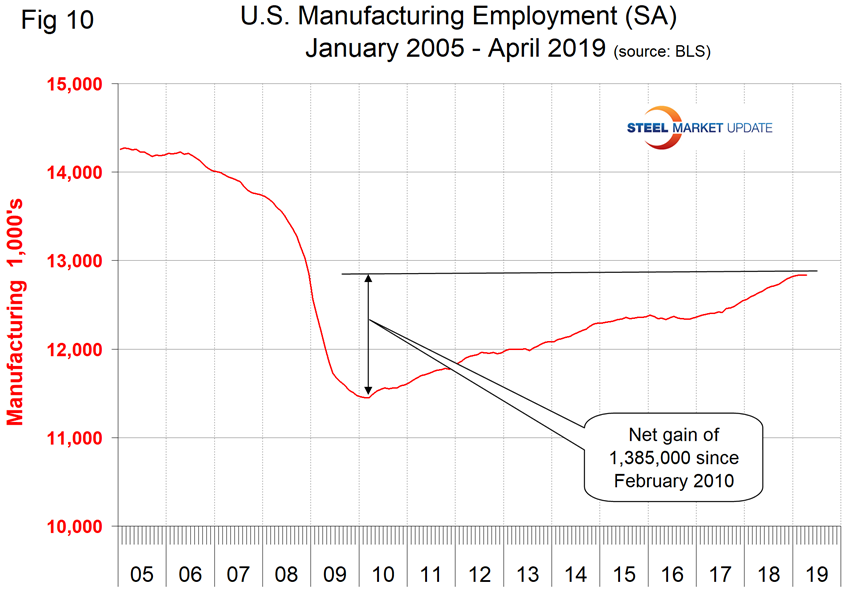
Manufacturing Productivity
The Bureau of Labor Statistics reported that in Q1 2019 manufacturing productivity completed three back-to-back quarters of growth over 1.0 percent, the best performance since 2010 (Figure 11).
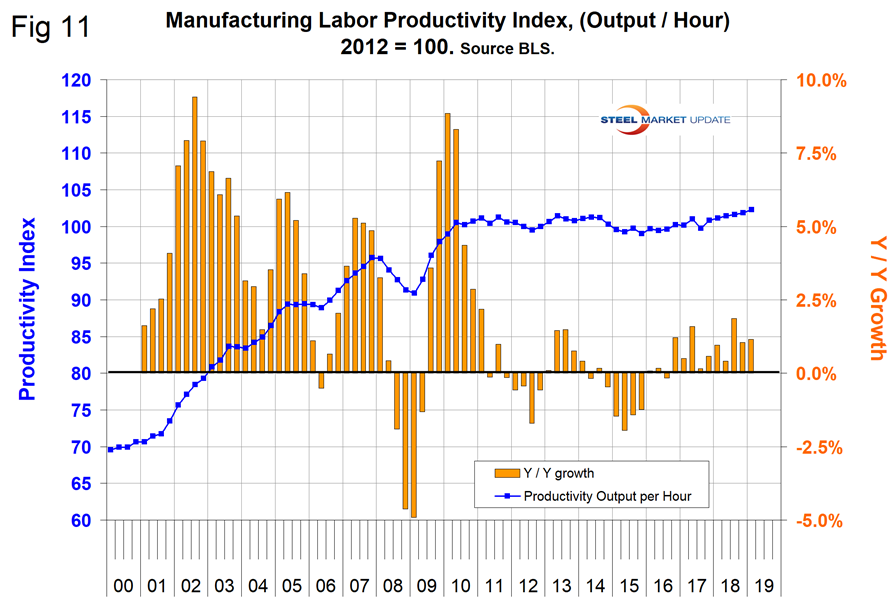
The ISM Manufacturing Index
The Institute for Supply Management’s Manufacturing Index is a diffusion index. ISM states: “Diffusion indexes have the properties of leading indicators and are convenient summary measures showing the prevailing direction of change and the scope of change. An index value above 50 indicates that the manufacturing economy is generally expanding; below 50 indicates the opposite.” Figure 12 shows the 3MMA of the ISM index from January 1997 through April 2019. The index surged from January 2016 through October 2017, leveled off through October 2018 and has declined since then. The index had a value of 52.8 in April with a 3MMA of 54.1, down by 5.03 percent year over year.
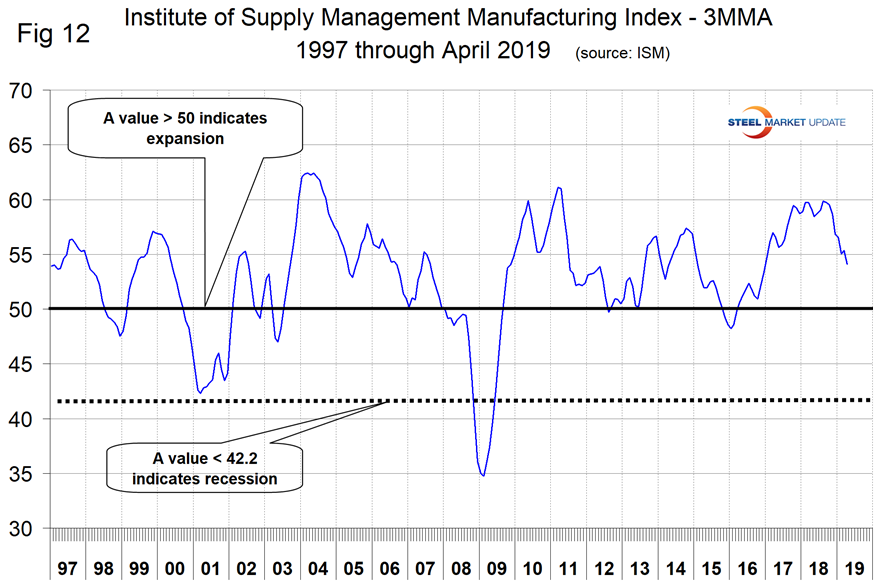
SMU Comment: Manufacturing activity is still strong, but there is an indisputable slowdown. The only encouraging current data point is the improvement in manufacturing labor productivity, but this may be driven by a management squeeze in the face of declining orders. The ISM index is still signaling growth, but if the trend continues that will reverse by late summer.

Peter Wright
Read more from Peter WrightLatest in Economy

AISI: Raw steel production ticks up near recent high
The volume of raw steel produced by US mills inched higher last week, according to the American Iron and Steel Institute (AISI). After steadily increasing in April and May, domestic mill output stabilized in early June and has remained historically strong since.

Steel groups welcome passage of budget bill
Steel trade groups praised the passage of the Big Beautiful Bill (BBB) in Congress on Thursday.

Industry groups praise Senate for passing tax and budget bill
The Steel Manufacturers Association and the American Iron and Steel Institute applauded the tax provisions included in the Senate's tax and budget reconciliation bill.

Chicago PMI dips 0.1 points in June
The Chicago Purchasing Managers Index (PMI) slipped 0.1 points to 40.4 points, in June.

Multi-family pullback drives housing starts to 5-year low in May
US housing starts tumbled in May to a five-year low, according to figures recently released by the US Census Bureau.
